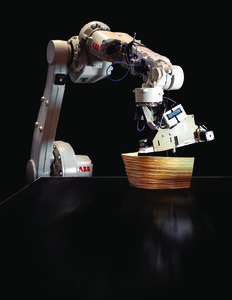| dc.date.accessioned | 2023-07-27T09:41:15Z | |
| dc.date.available | 2023-07-27T09:41:15Z | |
| dc.date.issued | 2021-08-13 | |
| dc.identifier | doi:10.17170/kobra-202307278503 | |
| dc.identifier.uri | http://hdl.handle.net/123456789/14935 | |
| dc.description.sponsorship | Gefördert durch den Publikationsfonds der Universität Kassel | ger |
| dc.language.iso | eng | |
| dc.rights | Namensnennung 4.0 International | * |
| dc.rights.uri | http://creativecommons.org/licenses/by/4.0/ | * |
| dc.subject | timber construction | eng |
| dc.subject | robotic fabrication | eng |
| dc.subject | sustainability | eng |
| dc.subject | additive manufacturing | eng |
| dc.subject | 3d printing | eng |
| dc.subject | bio-printing | eng |
| dc.subject.ddc | 600 | |
| dc.title | Additive Timber Manufacturing: A Novel, Wood-Based Filament and Its Additive Robotic Fabrication Techniques for Large-Scale, Material-Efficient Construction | eng |
| dc.type | Aufsatz | |
| dcterms.abstract | Additive manufacturing (AM), as resource-efficient fabrication processes, could also be used in the dimensions of the construction industry, as a variety of experimental projects using concrete and steel demonstrate. In timber construction, currently few additive technologies have been developed having the potential to be used in large scale. Currently known AM processes use wood in pulverized form, losing its inherent structural and mechanical properties. This research proposes a new material that maintains a complete wood structure with continuous and strong fibers, and that can be fabricated from fast-growing locally harvested plants. We describe the material technology to create a solid and continuous filament made of willow twigs and investigate binding and robotic AM methods for flat, curved, lamination, and hollow layering geometric typologies. The resulting willow filament and composite material are characterized for structural capacity and fabrication constraints. We discuss our technology in comparison with veneer-based lamination, existing wood filament printing, and fiber-based AM in terms of fabrication, material capacity, and sustainability. We conclude by showing possible applications in the construction industry and future research possibilities. | eng |
| dcterms.accessRights | open access | |
| dcterms.creator | Eversmann, Philipp | |
| dcterms.creator | Ochs, Julian | |
| dcterms.creator | Heise, Jannis | |
| dcterms.creator | Akbar, Zuardin | |
| dcterms.creator | Böhm, Stefan | |
| dc.relation.doi | doi:10.1089/3dp.2020.0356 | |
| dc.subject.swd | Rapid Prototyping <Fertigung> | ger |
| dc.subject.swd | Holz | ger |
| dc.subject.swd | Holzkonstruktion | ger |
| dc.subject.swd | Robotik | ger |
| dc.subject.swd | Intelligente Fertigung | ger |
| dc.subject.swd | Nachhaltigkeit | ger |
| dc.subject.swd | 3D-Druck | ger |
| dc.subject.swd | 3 D bioprinting | ger |
| dc.type.version | publishedVersion | |
| dcterms.source.identifier | eissn:2329-7670 | |
| dcterms.source.issue | Issue 3 | |
| dcterms.source.journal | 3D Printing and Additive Manufacturing | eng |
| dcterms.source.pageinfo | 161-176 | |
| dcterms.source.volume | Volume 9 | |
| kup.iskup | false | |


